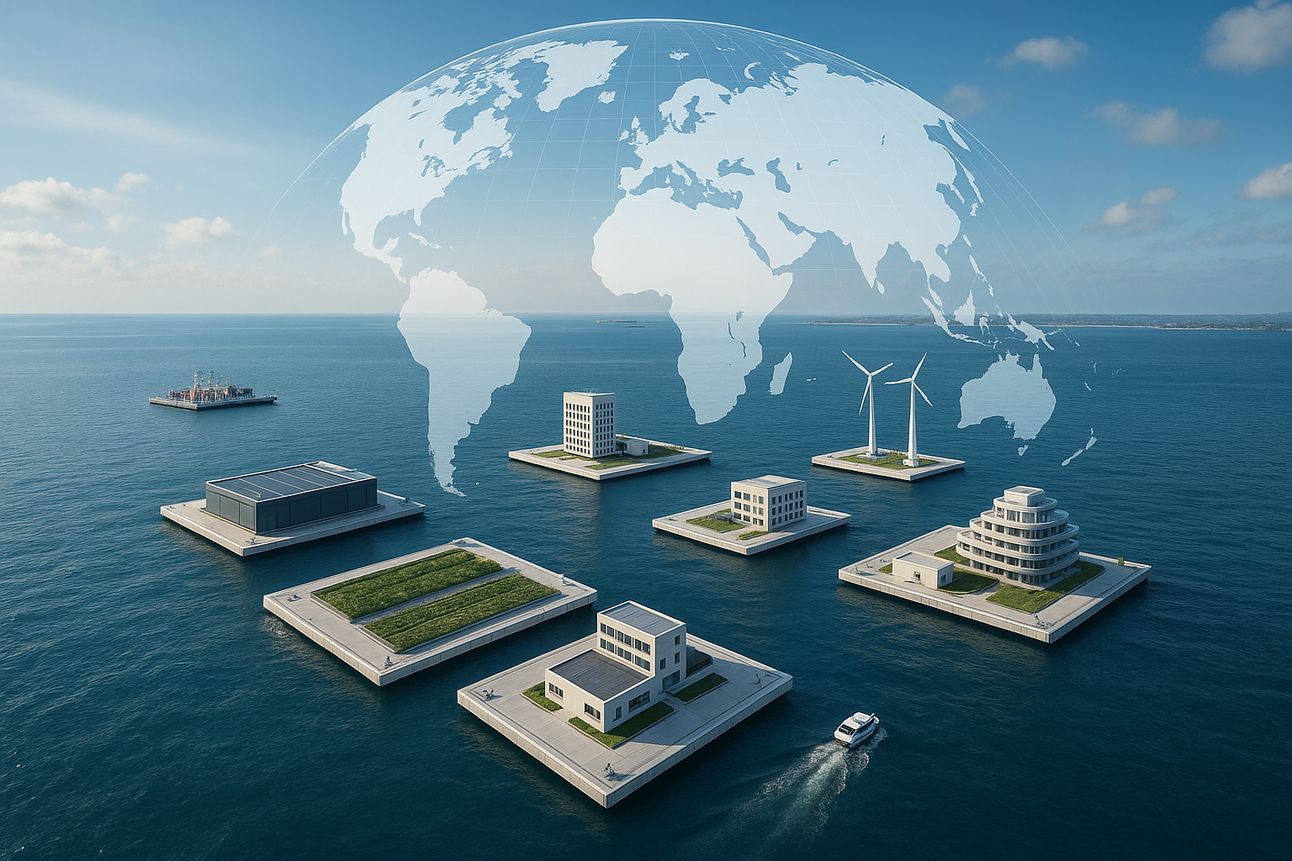
The world of maritime infrastructure is undergoing a profound transformation.
According to The Floating Institute’s latest research, The Floating Economy is projected to reach $1 Trillion by 2045. This growth is reshaping the blue economy, opening new opportunities for entrepreneurs, investors, and innovators eager to stake their claim in this evolving market.
In this dynamic environment, one thing is clear: timing is critical. From modular construction methods to shifting regulatory frameworks, the current market landscape offers unique entry points for those prepared to navigate the complexities of the floating economy.
These figures highlight a significant opportunity, but they only scratch the surface.
Understanding this complex landscape requires distinguishing between several overlapping yet distinct frameworks. Each framework represents a different lens on how people create economic value on and around water.
This is a complete rethinking of how economic activity takes place on and around the water.
In this guide, we’ll explore:
What the floating economy is (and how it differs from other frameworks)
Emerging technologies and market dynamics
Strategic implications for entrepreneurs and investors
How to position yourself in this fast-growing market
Let’s dive in. 👇
🚤 What is the Floating Economy?
The floating economy encompasses economic activities that originate and thrive on the water, extending from floating cities and offshore logistics hubs to aquaculture farms and maritime innovation platforms.
These activities are a growing part of a new trillion-dollar global sector that’s capturing investor, government, and entrepreneurial interest worldwide.
🌊 Other Frameworks for Water-Based Economic Activity
The Floating Institute has identified key frameworks that define the modern water-based economy. Each offers unique opportunities and challenges for governments, investors, and entrepreneurs.
The Ocean Economy
Scope: Total economic value from all ocean-based activities
Focus: Land-based value creation from ocean resources
Key Characteristic: Includes direct and indirect contributions to global GDP
The Ocean Economy is the broadest category, encompassing industries like shipping, fisheries, tourism, offshore energy, and marine biotechnology. It captures how ocean resources fuel growth on land.
The Blue Economy
Scope: Ocean economy with environmental consciousness
Focus: Balancing economic growth with ecosystem preservation
Key Characteristic: Policy-driven sustainability framework
Popularized by Belgian economist Gunter Pauli and adopted by the UN, the Blue Economy emphasizes sustainable practices in ocean development. It’s a response to rising concerns about environmental degradation and lagging productivity in marine industries.
The General Marine Industry
Scope: Traditional water-based industries serving land needs
Focus: Using marine environments as platforms for terrestrial demands
Key Characteristic: Established sectors with incremental innovation
📈 Current Market Dynamics Across Frameworks
Documented Growth Patterns:
Offshore renewable energy surge
Global offshore wind capacity increase
Maritime technology adoption
Multi-use ocean development expansion
Cross-Framework Trends:
Environmental Integration: All frameworks increasingly incorporate sustainability concerns
Technological Convergence: Digital transformation reshapes traditional and emerging sectors
Regulatory Evolution: International frameworks evolving for offshore activities
Market Sophistication: Investor interest is growing across all water-based opportunities
🗓️ Why 2025 is Pivotal
Historically, floating infrastructure faced challenges: high upfront costs, complex logistics, and fragmented regulations. However, 2025 represents a turning point, thanks to advancements in modular technology, supportive government policies, and increasing coastal population pressures.
Modular construction and advanced materials are enabling faster deployment and lower maintenance costs, though precise cost savings vary by project and region.
Regulatory frameworks are slowly harmonizing, making it easier to secure permits and licenses for offshore projects.
Governments are beginning to roll out incentives, offering grants and subsidies to spur investment.
These changes create a more predictable environment for entrepreneurs looking to enter or expand within the floating economy.
📊 Comparing Traditional Maritime and the Floating Economy
Aspect | Traditional Maritime Economy | The Floating Economy |
|---|---|---|
Primary Focus | Land-based trade and logistics | Offshore platforms and floating hubs |
Revenue Growth | Steady, incremental | Potential for rapid growth in niche markets |
Technology Readiness | Established technologies, gradual updates | Adoption of modular and digital systems |
Investment Channels | Conventional finance, infrastructure funds | Growing interest from private equity and venture capital |
Regulatory Environment | National jurisdiction, fragmented | Emerging frameworks with international potential |
Key Drivers | Trade, port development, shipping | Urban population growth, tech convergence, real estate scarcity |
💰 Key Opportunities in 2025
Expanding Investment Flows
Private equity and venture capital are increasingly exploring opportunities in floating data centers, aquaculture, and offshore logistics. While the pace varies by region, this trend highlights a growing appetite for floating economy projects.
Modular Technology Adoption
Modular construction systems are enabling projects to scale more efficiently compared to traditional builds. This trend is reducing project risk and improving adaptability, though quantitative metrics vary by market.
Coastal Real Estate Pressures
Coastal cities continue to grapple with land scarcity and rising property prices. Floating infrastructure presents a viable alternative, creating opportunities for mixed-use development that blends housing, tourism, and commerce.
Supportive Policies and Incentives
Governments in Asia and Europe are beginning to introduce tax incentives and grants to attract private investment in offshore projects. These incentives vary widely by country and require local expertise to navigate effectively.
🛠️ How to Get Started
1. Identify Your Niche
Select a market segment where your expertise and business model align with emerging needs.
2. Explore Funding Options
Leverage private equity, venture capital, and government-backed incentives to finance your project. Early-mover investments often receive priority consideration.
3. Develop Modular Infrastructure
Design scalable, adaptable platforms that can expand in phases as demand grows.
Collaborate with maritime legal experts to understand jurisdictional requirements and streamline approvals.
5. Build a Multi-Disciplinary Team
Assemble a team with engineering, operations, and business development skills. Success in the floating economy requires cross-functional expertise.
🌊 The Road Ahead
The floating economy is a strategic opportunity for local governments, entrepreneurs, and investors ready to shape the future of maritime industries.
At The Floating Institute, we provide market insights, regulatory analysis, and practical strategies to help you navigate this complex, opportunity-rich sector.
If you’re ready to explore new horizons, let’s dive in together.
